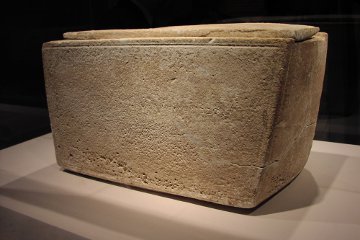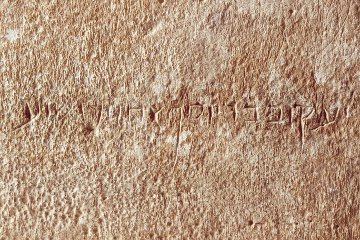The James Ossuary - Again
The facts about the James Ossuary are clear and indisputable. It is a genuine first century AD ossuary, it bears an inscription saying "James son of Joseph brother of Jesus" (to use modern equivalents of the Hebrew names), it was found in the home of Oded Golan, a Tel Aviv collector, who claimed to have purchased it some years previously. It is the interpretation of those facts that has caused - and continues to cause - heated dispute.
Oded himself is a slightly shady character who lives on his own with a dog and a white piano and a collection of artefacts, most of which are genuine. He shuns the limelight and both the Ossuary and the Jehoash Inscription were published as belonging to "anonymous" - a wise precaution in view of the fact that the Inscription is almost certainly fake. Even his tale about purchasing the Ossuary a long time ago from someone unknown is questioned, for it is possible that it was bought much more recently and therefore should belong to the state, which claimed all artefacts discovered after 1978.
Even more damning is the claim that when Oded was arrested, police discovered a complete forger's workshop in his house and evidence that he and his associates had sold dozens of forgeries to collectors around the world. If guilt can be proved by association, then the James Ossuary is certainly guilty.
Fortunately, however, the scholarly world requires a more definite evidence of guilt, for even a forger can have genuine objects in his possession. The scientific evidence hinges on a fairly arcane question: the patina in the letters.
Patina is the natural discolouring that appears on the surface of old objects. You might say that rust as a patina on objects made of iron. Stone acquires a different sort of patina, depending on the type of stone and its location. The James Ossuary, which is made of local limestone and should be gleaming white, has a reddish patina acquired through its burial in the ground. No one questions that this patina is genuine.

| |
| The James Ossuary, showing the inscription that has aroused so much controversy. |
One of the first things the experts did was to examine the letters which were scratched into the side of the ossuary, for if they were recent, they would have cut through the ancient patina and should show up as gleaming white. Of course, no competent forger would be so crass and there are various ways of faking a patina, some of which might be quite persuasive so long as there was no genuine patina with which to compare it. In this case there is genuine patina and the most careful examination of the patina, both visually and by a variety of chemical tests, appears to prove that the patina inside the grooves is identical to the patina on the rest of the ossuary.
Another complicating factor in the story of the James Ossuary is the curious ambivalence of the Israel Antiquities Authority (IAA). When the ossuary was first identified, experts from the IAA examined it and pronounced it to be genuine before - perhaps reluctantly - handing it back to its legal owner, Oded Golan. Excited by this discovery, the Royal Ontario Museum contacted Golan and - no doubt for a consideration - received permission to put the object on display in Canada.
It appears that once the contract had been signed, Golan tucked the thing under his arm and strolled down to his local post office, popped it in a Jiffy Bag and stuck the necessary stamps on the outside. The result was that when it arrived at the museum, the museum authorities were horrified to find that it had cracked in two!
However there is no loss without a corresponding gain: as the Royal Ontario Museum's team of restorers swung into action they had an unprecedented opportunity - and excuse - to examine the ossuary in detail. In particular, they examined it by ultraviolet light, a method which is used to detect modern interference with an antiquity. The Ossuary passed the test and was subsequently exhibited for three months, attracting queues of eager viewers.
There was considerable surprise, therefore, when the IAA seized the ossuary as soon as it arrived back in Israel, gave it a cursory glance and declared that it was a fake! To back up this astonishing volte face, the IAA declared that its geologists had conducted an oxygen-isotope test on the patina and established that the amount of oxygen in the patina differed from that of the patina on other, comparable, objects. They held a press conference to announce this result and lined up a panel of tame experts who unanimously declared the Ossuary a fake.
Given that the Ossuary had previously been examined by experts in all those fields and declared genuine, the IAA had an uphill job to establish its credibility - and the obvious next step was to arrest Oded Golan for forgery. That was when the police claimed to have discovered the forger's workshop and the evidence of large-scale forgery.
The debate became international and a television documentary was made on the subject. As part of the publicity for the film, Jerusalem's Cinematique arranged a public screening and debate, to which they invited the press and a panel of Israeli' scholars. To everyone's surprise - though presumably, not that of the film-makers - the scholars were almost unanimous in declaring the Ossuary to be genuine.

| |
| Detail of the inscription, which reads from right to left YAQWB BR YWSF AXWY D YSWA - or, to stick in the vowels and breathing marks, "Yaqob bar Yuseph, achuyi d Yeshu'a". |
A special guest at the programme was none other than Oded Golan himself, recently released from police custody. Golan vigorously defended his story of how the Ossuary had been acquired and identified and went so far as to hint that there was a conspiracy in the IAA against him. Whether or not that is so, more than one person has suspected that there is a conspiracy in the IAA against Christianity and that it was the excitement among Christians in Canada rather than genuine doubts about the Ossuary which prompted the investigation and prosecution.
The biggest stir was caused when Shimcah Yadobovitch, the director of the documentary, revealed that he had interviewed the head of the Israel Geological Survey, asking him about the isotope test. During the interview this man admitted that patina can be contaminated - that is, the oxygen levels can be altered - either by deliberate action by a forger, or by something as simple as running a wet cloth over the object! Goded was just about jumping up and down in excitement at this point. "I have owned the ossuary for over twenty-five years," he declared. "Most of those years it was at my parents' house and it is probable that my Mum cleaned it from time to time to get the dust off!
Because the Ossuary was not found in a proper, legal excavation, it will never be possible to be 100% certain that it is not a clever fake. So far it appears to have passed all the tests, with experts in patina, paleography and archaeology declaring it to be authentic. If it is genuine, of course, that will mean that the Biblical account of James, the brother of Jesus, passes definitely from the realm of myth to that of fact. If it is false, we are no worse off than if it had never been discovered and the existence of James depends on literary and historical evidences rather than archaeological ones.
Since this article was published in 2003 the trial of Oded Golan was abandoned. The world's foremost expert in patina testified to the genuineness of the Ossuary's patina, both inside and outside the grooves, and the learned judge advised the IAA to give up. It would seem that the James Ossuary is genuinely what it appears to be and the Bible is once again demonstrated to be correct in its historical statements.
Indeed, one can go a little further and point out that it is highly significant that this James the son of Joseph should be identified as "the brother of Jesus", indicating that Jesus Himself had an historical existence and was considered so significant a character that His name was quoted on His brother's ossuary. That is far from confirming the Christian claims regarding the divinity or even the Messiahship of Jesus, but it is confirmation that people before AD 70 regarded Him as significant.





